
John Smibert
John Smibert (Also known as John Smybert) was a Scottish American artist. You can find John Smibert paintings in various art museums:
- The Museum of Fine Arts, Boston - Daniel, Peter, and Andrew Oliver
- The Art Gallery, Yale University - The Bermuda Group
- Smithsonian American Art Museum - A Member of the Livingston Family
- The Museum of Fine Arts, Houston - Portrait of Samuel Pemberton
- Faneuil Hall - Peter Faneuil Portrait
The painting at Yale University was John Smibert favorite painting as it hung in his Boston office for everyone to see.
Bronze 20" x 20" Monument
Next to the entrance to the Granary Burying Ground is this monument:
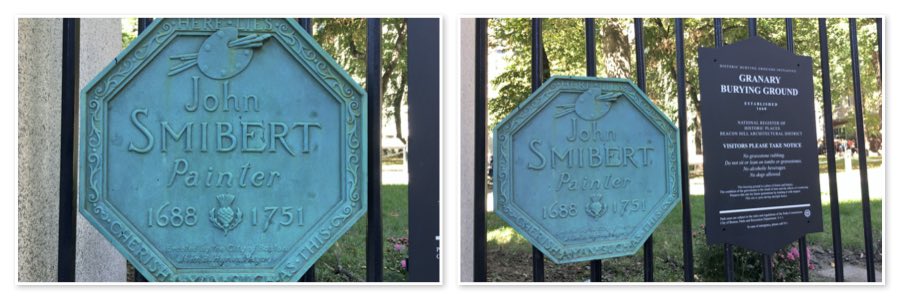
Here lies John Smibert
Painter 1688 - 1751
Cherish A Man Such As This
Erected by the City of Boston
John B. Hynes, Mayor
In tiny print you can see: "Ca Ascieri Adi Biccari." I wasn't able to find the date that the Bronze monument was placed, but I suspect it was in 1951 which would have been the 200 anniversary of John Smibert death.
Five things I learned about John Smybert
- Born in Edinburgh, Scotland in 1688 and died in Boston in 1751.
- Considered to be America's First Portrait Painter.
- Organized Boston's first painting exhibition in 1730.
- In 1742, John Smybert designed Faneuil Hall. Faneuil Hall was destroyed in a fire in March 1761, it was rebuilt shortly after keeping many of the original designs.
- He is buried in an unmarked grave at the Granary Burying Ground, Boston, MA.
- In Colonial times people that couldn't afford their gravestones were buried in unmarked graves. It's possible that John Smibert was a poor man when he died.
Boston Neck 2017
The Boston Neck was a small strip of land connecting the mainland to the then-peninsular city of Boston. Over the years the area was filled in as the City of Boston popular grew.
The Boston Neck was an important part of the American Revolution as the British closed the access way into the City of Boston. This was part of the British Seize of Boston April 19, 1775 - March 17, 1776.
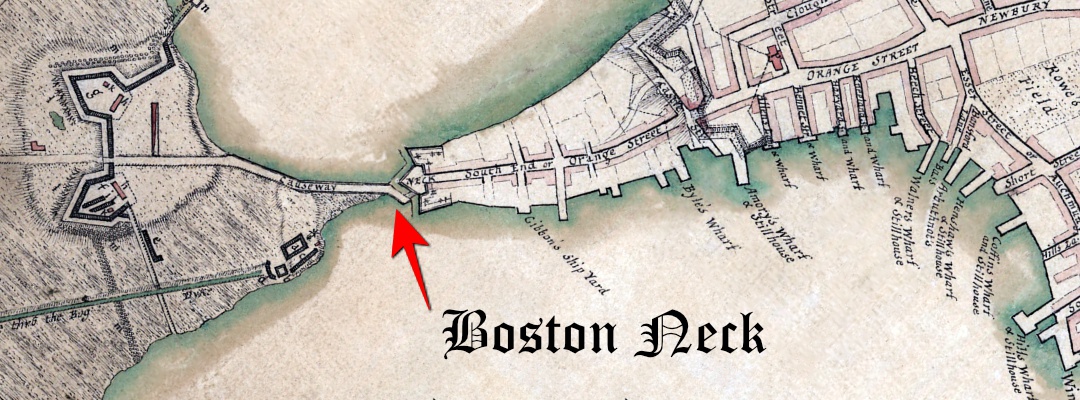
William Dawes Journey
On the night of April 18, 1775, William Dawes snuck pass the checkpoint and rode south to warn the British were coming. Paul Revere avoids the checkpoint by crossing the Charles River by rowboat. Both patriots would meet up in Lexington and continued their journey to Concord.
The Gallows
Nearby the Boston Neck is where criminals, religious rebels, and other Colonial-era offenders were publicly hanged. Many published reports that hangings were done at the Boston Commons. This is probably because the area where the hanging was done was called the "Commons Land."
The bodies were then dumped or buried nearby, reportedly leaving unhappy ghosts to haunt the surrounding neighborhood.
Boston Neck in 2017
There are no markers to indicate where the Boston Neck was. Historians that are looking for the exact location will find this overlay map very handy:
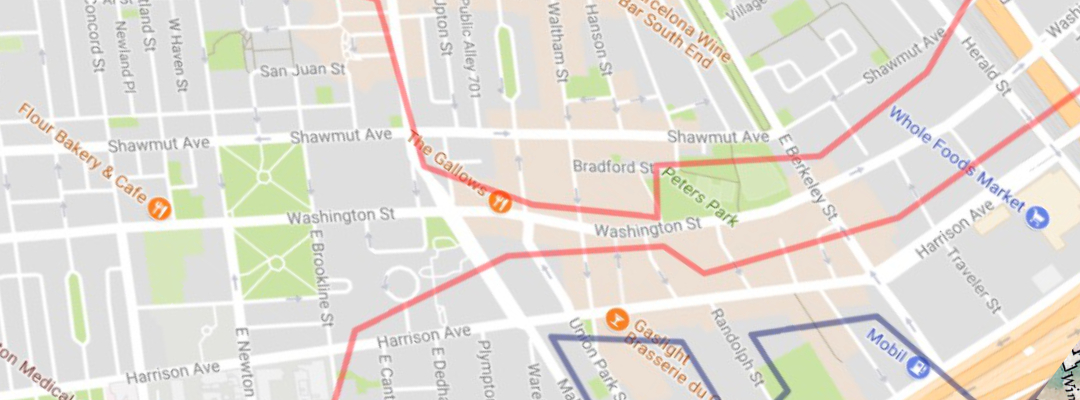
The neck was located between Peter's Park and the Cathedral of the Holy Cross.
The only thing that shows the history of the area is at the Union Park Street (Silver Line MBTA station). There's a couple of permanent wall posters of this history of the area.
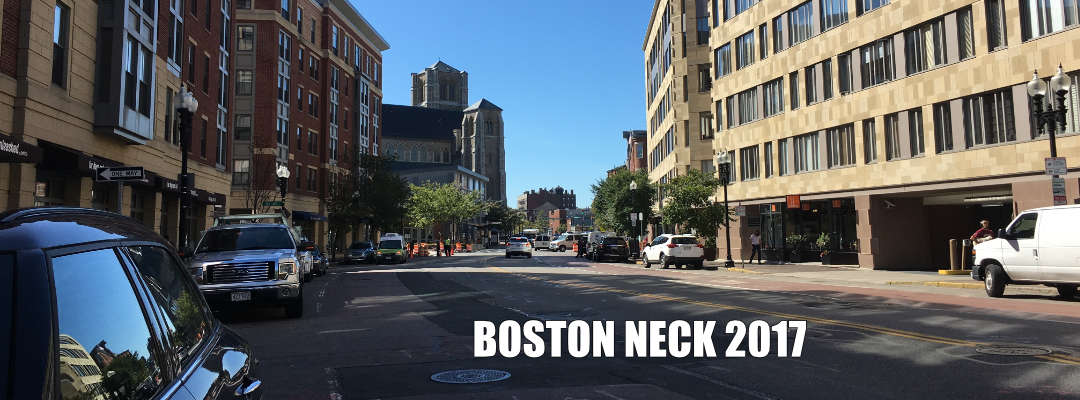
There is a small park nearby, Peter's Park, where a statue or monument could be placed on the history of the location. Perhaps something to mark William Dawes contribution to the American Revolution.
What do you think? Should the city of Boston put a historical monument about the Boston Neck?
PermalinkMassachusetts State House Library
The Boston State House is a great place for tourists to learn about the History of Massachusetts.
The State House tours are free and its a great way to learn about the historic building. One location not on the tour is the State House Library. (I suspect this is because people are asked to be quiet in the library.)
The library is open to the public, you don't need to be a researcher to visit the State House Library. If visiting Bates Hall at the Boston Public Library is on your agenda then I would recommend checking the State House Library.

Six Things I Learned about the State House Library
- Open in 1826. 40 years before the Smithsonian and 20 years after the Library of Congress opened.
- In the current location since 1890
- The Library is named after George Fingold who was the Attorney General of the Commonwealth from 1953 to 1956.
- The official symbol is a half circle stain glass window. You can purchase unique souvenir items at the library desk. (You contribution helps support the library.)
- You need a library card to use the computers. There are computers on the first and second floor.
- To get a Library Card you need to be employed by the Legislative or Executive Branch. Unfortunately, the general public isn???t allowed to use the computers.
Stain Glass Ceiling
When you're in the library, look up at the stain glass ceiling. You will notice three distinct years on the glass:

- 1620 - Plymouth Plantation is founded
- 1775 - A New Nation is formed. The declaration of Independence is signed.
- 1861 - The start of the Civil War.
I had to ask the Librarian on what the significance of 1861. I thought it might be when the State House was moved. She told me that it???s there to remember the start of the Civil War. (The State House was moved from the Old State House in 1798)
Temporary Exhibits
The State House Library has temporary exhibits to highlight some of its collection. They are now showcasing Massachusetts Symbols, such as the official State Cookie and the Official State Book.
Find out what the: Official Sport, Recreational and Team Sport, State Berry, State Bean, State Beverage, State Groundhog, State Cat and many more!
Some future Massachusetts State Symbols under consideration: Country Song, Seasoning, Shellfish, Textile, Cupcake, Patriotic Song and more.
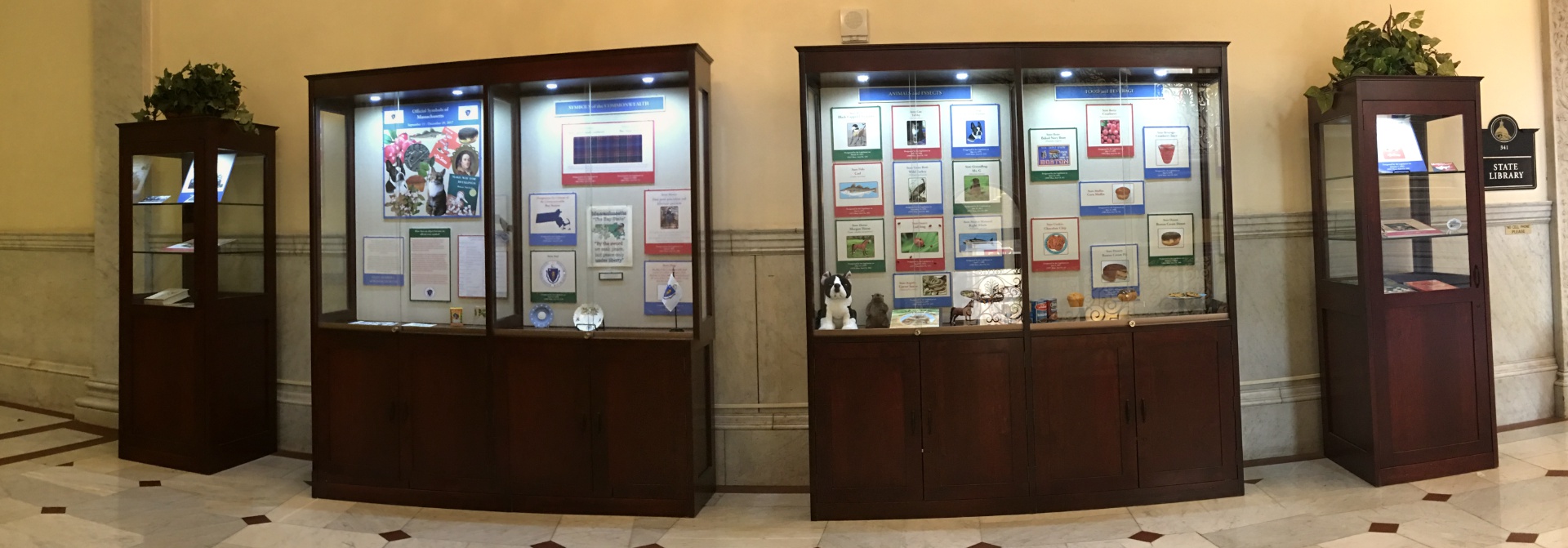
The exhibit will be on display until the end of the year.
Visiting the State House Library
The State House library is located in the back of the State House on the third floor. From Monument Court, go up the Grand Staircase and turn left. Keep walking until you see the State House door.
The Temporary Exhibits are outside of the State House Library.
PermalinkUnion Oyster House
The Union Oyster House is the oldest restaurant in Boston and the second oldest in the United States. The restaurant opened in 1826 and continues to be a favorite for locals and tourists.

Ten Things I learned about the Union Oyster House
Some things that I learned about this historic establishment.
- Hawes Atwood founded the oyster house on October 7, 1826
- The establishment had various names over the years:
- 1826 -1842 - Atwood's Oyster House
- 1842 -1860 - Atwood & Hates
- 1880 - 1916 - Atwood & Bacon
- 1916 - 2018 - Union Oyster House
- The Atwood family were the original owners and owned the place for 87 years. Other Owners over the years:
- 1826 - 1913 - ( 87 Years ) Atwood Family
- 1913 - 1927 - Fitzgerald Family
- 1927 - 1970 - ( 57 Years ) Fred L. Greaves
- 1970 - current (47+ Years) Mr. Joseph A. Milano, Jr., and Ms. Mary Ann Milano Picardi.
- Formed as a corporation in March 9, 1914 by Fred L. Greaves, Charles A. Ross and John D. Marks for $5,000.
- The "Old Oyster Bar" inside the restaurant is the orginal one which was built in 1826.
- James Farren was one of the original Oyster openers. He was a champion long-distance oyster opener over the 55 years he opened approximately 6,000,000 oysters.
- In 1933, in the middle of the Great Depression, the Union Oyster House expanded by opening a second-floor dining room capable of seating an additional 50 customers. In 1941, the oyster house opened three new dining rooms on the second floor and installed a new kitchen and bakery with all new cooking and dishwashing equipment
- The large sign on the top of the Union Oyster House has been there since 1957. The street level sign outside of the building has been there since 1956.
- Kennedy Booth - Upstairs is where you'll find Booth 18. That is where John F. Kennedy ate at the Union Oyster House. (It was his favorite restaurant) Senator Edward Kennedy would also eat at the same booth.
Sign reads:
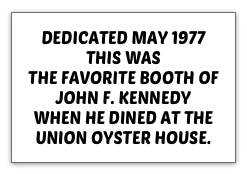
- Listed as part of the National Historical Landmark in 2003. Only the main building is considered a landmark, the expansion done in 1941 doesn't count as part of the National Historical Landmark. The Landmark sign outside is on the building that is designated as a landmark.
- On November 28, 191, Frank Kelleher ate a total of 120 oysters at Union Oyster House, breaking the previous record of 84 oysters eaten by a Harvard student in 1916. He accomplished this in 2 hours and 15 minutes. (He would have kept going but his friends convinced him that it wasn't necessary.)
Building History
The building that occupied by the Union Oyster House was built in 1714 and has been an oyster house since 1826. Before that, it was a dry goods store wherein 1769 Benjamin Thompson, conducted early experiments with gunpowder and pressure cabinets.
The building also serves as headquarters for revolutionary movements. Between 1771 and 1775 Isaac Rogers published there the famed Revolutionary "Massachusetts Spy"
Daniel Webster Sign: The Original U-Shaped Mahogany Oyster Bar where Daniel Webster was a Constant Customer. He Drank a Tall Tumbler of Brandy and Water with Each Half Dozen Oysters and Seldom had less than Six Plates
PermalinkJohn Winthrop Statue
John Winthrop (1588-1649) was an English Puritan lawyer and one of the founders of the Massachusetts Bay Colony. He served twelve terms as Governor between 1630 and 1649 and he was one of the founders of the First Church in Boston, which was established in 1630.
John Winthrop died in 1649 and is buried at the King's Burial Grounds.
In 1880, the City of Boston commissioned a statue of John Winthrop and put it in Scollay Square at the 250th anniversary of the founding of Boston. (September 17, 1880)
The statue was moved in 1904 as the area was being refitted for the new MTA subway station. Scollay Square was renamed Government Center. The statue ended up in front of the First Church in Boston.

Twelve things I learned about John Winthrop and the statue
- The bronze statue was done by Alessandro Nelli in 1880.
- The statue is 7' by 2.5' by 2.25' on top of a 4' by 8' concrete base.
- The face is based on the Vandyke Portrait which is now on display at the Harvard Art Museum.
- This is bronze statue is a replica of a marble statue that is located in Statuary Hall in the U.S. Capitol building which was done by Richard Saltonstall Greenough in 1876.
- Congress allowed Massachusetts to have two statues in the Capital Building Statuary Hall. The other statue representing Massachusetts is Samuel Adams. John Winthrop beat other historical notables such as John Hancock and Paul Revere.
- The John Winthrop statue was on display in the vestibule of the Boston Athenaeum for four years before being placed in Scollay Square.
- The statue shows John Winthrop holding the Bible in his right hand - close to his heart. In the left hands are the scrolls to the Massachusetts Charter. The body is position as if he is about to step off the "Arbella" to the New World
- To the side is a tree stump with a rope around it - holding the vessel to the wharf.
- In 1968, the statue was damaged in a major fire was at the First Church. Part of the building hit the statue and the head fell off. The head was never recovered and mysteriously disappeared.
- The statue was removed from the site for repairs and was placed back in 1975. The original head was never found.
- There are two sculpture signatures on the statue: R J Greenough Sculp 1873 and Alessandro Nelli 1880
- In 1974, a request was made to move the statue to Winthrop Square in Boston's Financial District. (People thought it was weird to have a square named "Winthrop" without a proper statue.) The First Church declined the offer. The owners of the square eventually settled on the Scottish Poet Robert Burns who wrote the famous poem "Auld Lang Syne."
Note: I was able to figure out that Alessandro Nelli worked on the statue even though nobody gives him credit. His signature is on the back of the statue. His work on this statue isn't even mentioned on the Wikipedia page.
Some John Winthrop Notable Firsts
American Slave Trade
The first documented reference to the slave trade in Massachusetts is the journal of John Winthrop (the founder of Boston), who recorded on 26 February 1638 that the Massachusetts ship Desire had returned from the West Indies carrying "some cotton, and tobacco, and negroes, etc., from thence..."
UFO Sighting
John Winthrop has the earliest recorded written record of a UFO in America. In 1639, Boston Founder and Governor John Winthrop made a peculiar entry in his journal. Within, he describes how several sober men spotted an unusual object in the sky that shone as a great light. The object was large and moved across the night sky that suddenly took on the shape of a pig.
Finding the John Winthrop Statue
The statue located near the corner of Marlboro and Berkley Street in the Boston's Back Bay. (299 Berkeley Street, Boston MA)
PermalinkHarriet Tubman Park
Born a slave, Harriett Tubman (1822 - March 10, 1913) became a famous "conductor" on the Underground Railroad, leading hundreds of slaves to freedom.
At the age of 28, she escaped slavery in Maryland when her master died. She spent the rest of her life helping other escape to the North and be free.
She died poor on March 10, 1913 in Auburn, New York.
Harriet Tubman never lived in Boston. She visited the city many times to recruit people to help with the Underground Railroad. She frequently stayed at the Lewis and Harriet Hayden House at 66 Phillips Street.
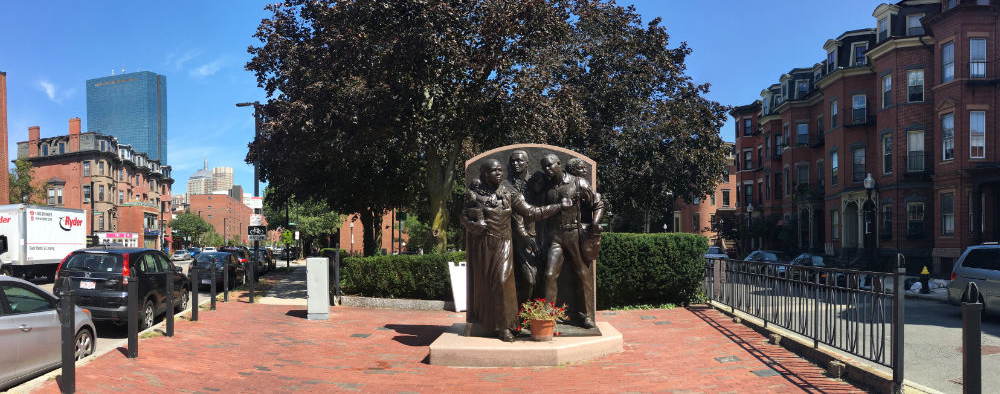
Ten Things that I learned about the Harriet Tubman Square
- Opened on June 15,1999 (86 years after her death)
- The square is only 8,712 square-feet. The sculpture is 10-foot-high and 7-foot-wide titled "Step on Board"
- According to the Boston Art association this is the first statue in Boston property to be honoring a women. Some people may think that the Mary Dyer statue is the first but thats on State House property.
- Created by Fern Cunningham, a local sculpture.
- The Harriet Tubman statue is showing her leading others to freedom with the bible under her arms. Fern Cunningham put her father's face on one of the runaway slaves.
- There are two monuments in Harriet Square. The Harriet Tubman statue is at the xxx. The Emancipation statue is in the center of the square.
- The Emancipation statue was created in 1913 Emancipation by Meta Vaux Warrick Fuller (1877-1968).
- The Emancipation statue was once in Park Square. It was recast and placed in the Harriett Tubman park.
- On the ground around the Harriet Tubman Statue are pavers created by children in Brookline and the South End. These pavers represent quilts designs that were hung in the windows as a secret message to those going on the Underground Railroad.
- The Harriet Tubman House, a settlement house for black women who had migrated from the South, is nearby at 566 Columbus Ave.
Only Outdoor Monument to Herriet Tubman?
There is a Harriet Tubman statue in New York city it was put up on November, 13, 2008. In 2016, there was a movement to put one in the Capital building in Washington DC.
Did you know that in 2015 Harriet Tubman was the "People's Choice" to be the next face on the $20 bill. She would replace Andrew Jackson. The last time the face on the $20 bill was changed was in the 1920s when Jackson replaced Grover Cleveland.
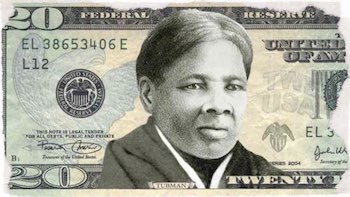
Sample design someone created
If she does replace Andrew Jackson, it could bring more attention to the Harriet Tubman Square.
In 1978, The United States Post Office included Harriet Tubman in their Black Heritage stamp Series.
Some Quotes attributed to Harriet Tubman
-- Harriet Tubman, Abolitionist
-- Harriet Tubman, Abolitionist quote on the back side of the monument.
-- Harriet Tubman, Abolitionist quote on the back side of the monument.
Boston Public Gardens Foot Bridge
The Boston Garden Footbridge is a small bridge that allows pedestrians a quick way to cross the lagoon at the center of the Boston Public Gardens.
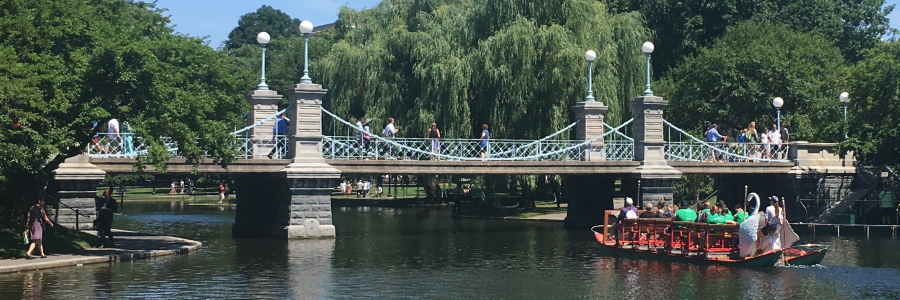
Ten things that I learned about the Public Garden Footbridge
- Created by Clemens Herschel and William G. Preston. Opened on June 1, 1867
- Clemens Herschel (March 23, 1842 - March 1, 1930) was an American hydraulic engineer. He is most famous for the Venturi meter which was the first large-scale, accurate device for measuring water flow.
- William G. Preston ( September 29, 1842 - March 26, 1910) was an American architect who also designed the building at 234 Berkeley Street, Boston, MA.
- Was once the world's shortest functioning suspension bridge before its conversion to a girder bridge in 1921. Its original suspension system is now merely a bridge decoration.
- Part of the Haffenreffer Walk - Named after a Jamaica Plain Beer baron Theodore H. Haffenreffer (l880-1956). The name of the walk was made popular by Gov John Hynes in the 1950s.
- Official registered on the National Register of Historic Places on February 27, 1987.
- Sometimes called the Lagoon Bridge. Official name is: Boston Public Garden Foot Bridge
- Bridge is made of Grey Stone and Steel.
- The bridge length is 104 ft (31 m), the width is 12 feet. The height under the bridge is 12 feet.
- On one of the Bridge post is a marker to remember Lt. Michael Patrick Quinn US, who died in Vietnam in 1969. He spent his summers working the Swan Boats before enlisting in the United States Marine Corps.
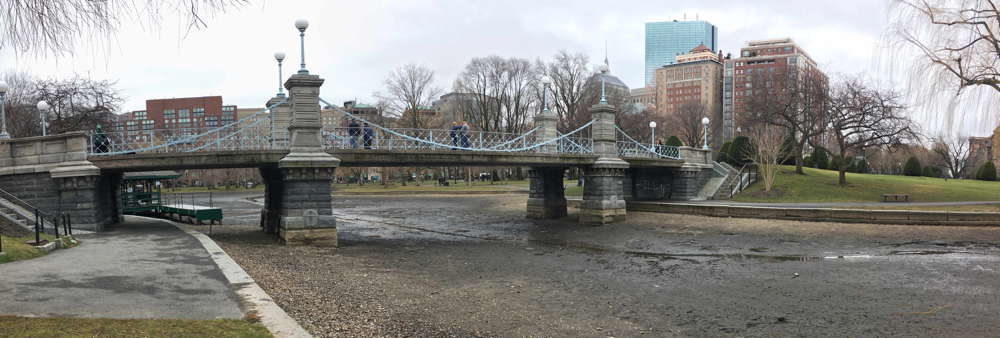
Winter View of the Bridge
Alexander Graham Bell
"Mr. Watson, come here -- I want to see you." Those famous words were uttered by Alexander Graham Bell on March 10, 1876, in Scollay Square in Boston. They were spoken at a workshop on the second floor of 109 Court Street.
Things I learned about Alexander Graham Bell time in Boston
- He came to Boston to teach visual communications to the Boston school for the deaf. The school originally wanted his father but Alexander did well enough in teaching the children that the school was satisfied with the replacement.
- He was a professor of the mechanism of speech at Boston University School of Oratory. He wanted to invent some device that would transmit sound over telegraph wires.
- Boston University invested in his telephone invention by paying his yearly salary up front.
- He witnessed the Great Boston Fire of 1872. He wrote his accounts of the fire in a letter to the Boston Globe. The Globe never posted his eyewitness to history.
- The building where the first telephone transmission was made was taken down in the 1920s.
- The laboratory was carefully moved to the Verizon Building. (It has since been removed to an undisclosed location.)
- The building at 109 Court Street was the birthplace of the first transmission of sound over the wire and the first use of the telephone.
Alexander Graham Bell Marker
On Court Street is a marker to where Alexander Graham Bell discovered the telephone
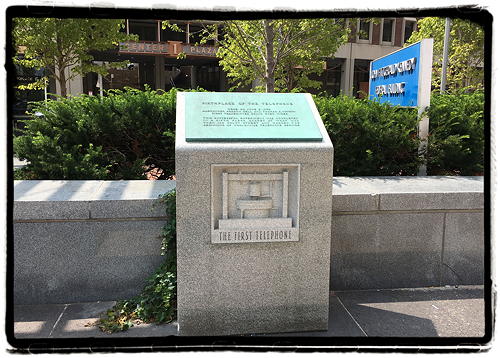
The marker reads, "Birthplace of the Telephone. Here, on June 2, 1875, Alexander Graham Bell and Thomas A. Watson first transmitted sound over wires. This successful experiment was completed in a fifth-floor garret at what was then 109 Court Street and marked the beginning of worldwide telephone service."
The marker is located next to the John Fitzgerald Kennedy Federal Building. You can see it next to the blue sign on the Cambridge Street side of the building. Simply walk along the Boston City Hall Plaza towards Sudbury Street. You'll see the "John Fitzgerald Kennedy Federal Building" sign. The marker is on the other side of the bushes.
Alexander Lived Here
While in Boston, Alexander Graham Bell lived at 38 W. Newton St., Boston MA. A petition was submitted to the Boston Landmark Commission to make it a landmark. The request was denied on April 1979. I assume that the original building was taken down to make room for modern buildings. It is now a private residence, there are no signs to indicated who lived there before.
Given the location of Alexander home and work, chances are that he might have walked the streets of Boston to get to and from work. He would know about the Great Elm of the Boston Commons and probably cut through the commons to get to his workshop.
Invented the Telephone?
Most people have been taught that Alexander Graham Bell invented the telephone. However, there is controversy on who really invented the telephone.
The telephone design was the patent on March 7, 1876. On January 13, 1887, the Government of the United States moved to annul the patent issued to Bell on the grounds of fraud and misrepresentation, a case that the Supreme Court found viable and remanded for trial.
107th Congress Action in 2001 and 2002
Members of the 107th Congress voted in favor for giving credit to Antonio Meucci as the inventor of the telephone:Whereas Antonio Meucci, the great Italian inventor, had a career that was both extraordinary and tragic;
Whereas, upon immigrating to New York, Meucci continued to work with ceaseless vigor on a project he had begun in Havana, Cuba, an invention he later called the ''teletrofono'', involving electronic communications;
Whereas Meucci died in October 1889, the Bell patent expired in January 1893, and the case was discontinued as moot without ever reaching the underlying issue of the true inventor of the telephone entitled to the patent; and
Whereas if Meucci had been able to pay the $10 fee to maintain the caveat after 1874, no patent could have been issued to Bell: Now, therefore, be it
Resolved, That it is the sense of the House of Representatives that the life and achievements of Antonio Meucci should be recognized, and his work in the invention of the telephone should be acknowledged.
Note: Only the House of Representatives voted on this action. No Senate vote was taken.
Remove the Alexander Graham Bell Marker?
Should Boston remove the Telephone marker near City Hall? Based on the actions by Congress, the marker gives false credit to Alexander Graham Bell as the inventor of the telephone.
PermalinkThe Ames Building
Between Faneuil Hall and the Old State House is the Ames Boston Hotel. This building is the first skyscraper in the city of Boston.
Things that I learned about the Ames Building.
- Built in 1891. The first tenant moved in January 5, 1891. (Old Colony Trust Company)
- The Ames Building is 196 feet high (14 stories) and occupies 93,000+ square feet. For a brief period of time, it was the tallest masonry building in the United States. The Monadnock Building in Chicago is the tallest masonry building.
- Tallest Building in the United States in 1893 was the Milwaukee City Hall at 354 ft.
- The building was never the tallest structure in Boston, the steeple of the Church of the Covenant has held that honor (236-foot)
- The Church of the Covenant lost its status in 1915. That's when the Custom House Tower was built in 1915. (The Customs House Tower is a few blocks away from the Ames Building.)
- In 1889 the Ames Building was estimated to cost $625,000 prior to construction. ( worth $15,376,496.02 in 2015. )
- Building architect was Shepley, Rutan and Coolidge - who also designed the South Station building and the Trinity Church in Copley Square.
- Offically listed as a Boston Landmark on November 23, 1993 (Exterior Landmark)
- Today the Ames Building is called the Ames Boston Hotel. There are 114 luxury rooms available. It's part of the Curio Collection by Hilton Hotels.
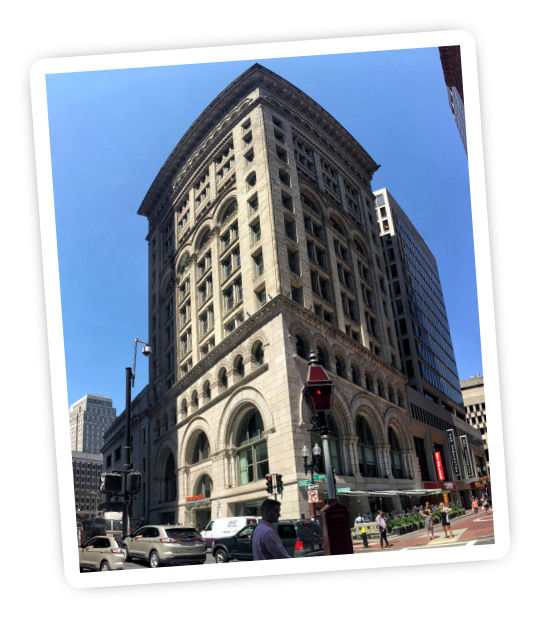
View from the Old State House.
Thanksgiving Day Fire 1889
Four firemen lost their lives in the construction of the Ames Building during a massive "The Thanksgiving Day Fire" on November 28, 1889. The fire was started in the basement of a warehouse about 5 blocks from the Ames Building. The fire destroyed hundreds of buildings and killed fourteen people.
Following firefighters were found dead in the Ames Building:
- John J. Brooks Jr., Hose Company 7, age 29.
- Michael Murnan, Hose Company 7, age 34.
- Daniel J. Buckley, Ladder Company 3, age 31.
- Frank P. Loker, Ladder Company 3, age 33.
- Edward E. Whiting
Time Ball
At one time there was a Time Ball on the top of the Ames Building. The ball was used to help mariners entering Boston harbor for the correction of their chronometers. Each day at exactly at noon the ball would be hoisted to the top of the pole on the Ames Building. The ball was put up on December 30, 1902 and taken down on September 7, 1923. It was removed since the invention of radio time signal the service was no longer needed
Sign at the Building
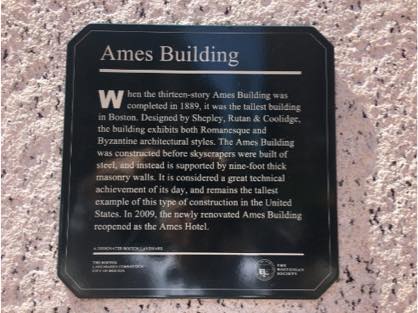
The Bostonian Society placed the following marker on the building:
When the thirteen-story Ames Building was completed in 1889, it was the tallest building in Boston. Designed by Shepley, Rutan & Coolidge, the building exhibits both Romanesque and Byzantine architectural styles. The Ames Building was constructed before skyscrapers were built of steel, and instead is supported by nine-foot thick masonry walls. It is considered a great technical achievement of its day and remains the tallest example of the type of construction in the United States. In 2009, the newly renovated Ames Building reopened as the Ames Hotel.
Location
The Ames Boston Hotel is located at 1 Court Street in Boston's Financial District. It's located directly across the street from the Old State House.
PermalinkDemocratic Donkey
In the courtyard of the Old City Hall is a statue of a Donkey and a pair of elephant footprints.
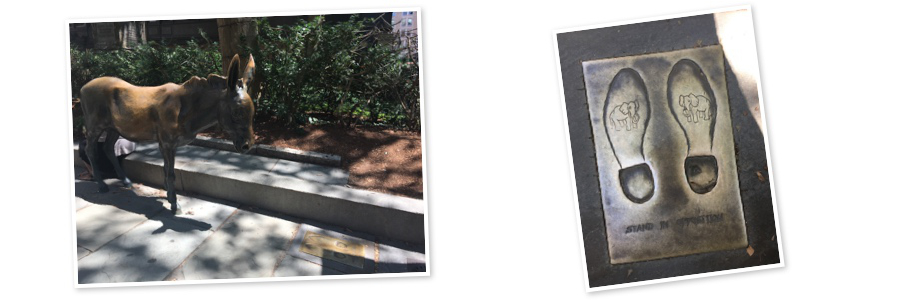
Interesting things that I learned about the Democratic Donkey
- Placed in 1998.
- Created by Antonio Frilli
- Statue was purchased by Roger Webb while vacationing in Florence, Italy.
- Roger Webb is the founder of the Architectural Heritage Foundation in Boston and help launch Preservation Massachusetts, a statewide nonprofit historic preservation organization.
- Roger wanted the statue so that children had a place to play as they walked the Freedom Trail.
- The City of Boston declined the initial request to install the statue along the Freedom Trail as they felt it wasn't appropriate to install an Italian Donkey.
- Rodger was able to convince the City when he explained that the Donkey was the symbol of the Democratic Party since the 1840s. The twenty mayors of Old City Hall used the mascot and the Bronze Donkey would be a symbol of that time.
- The Donkey is looking down at a pair of elephant footprints cast in bronze. (The Republican symbol is in the footprints.)
- There is a message before the footprint which reads, "Stand in Opposition."
- The bronze footprints were installed at the request of the Republican Party.
- The footprints were installed in 2001.
Democratic Donkey and the Republican Elephant
They were the inventions of Thomas Nast, an illustrator who became America's preeminent political cartoonist. Nast's donkey first appeared as a Democratic party symbol in Harper's Weekly on Jan. 15, 1870. The elephant turned up in Harper's four years later.
PermalinkAbout
There are many interesting things and places around Boston, MA that you should know about. Here are a few that caught my attention. From historical sites such as the USS Constitution Museum, the Freedom Trail, and the iconic Fenway Park, to modern attractions like the New England Aquarium, the Boston Public Market, and the Isabella Stewart Gardner Museum, there is something for everyone. Whether you are looking for a fun family trip or a romantic getaway, Boston has it all.
Check out all the blog posts.
Schedule
| Tuesday | QA |
| Wednesday | New England |
| Thursday | Gluten Free |
| Friday | Macintosh |
| Saturday | Internet Tools |
| Sunday | Open Topic |
| Monday | Media Monday |
Other Posts
- One Pinckney Street
- Grant Gately Square
- Prudential Preferred Shopper Card
- Oliver Ames Jr. Square
- Spanish/American War Cannons
- Boston Graphic Updates
- William Dawes
- Sailing the Charles River
- Boston 2024
- Martin Luther King Lived Here
- Samuel Eliot Morison Statue
- Boston's Haffenreffer Walk
- Top 5 Underrated Places in Boston to Have a Perfect Date
- Largest Parking Garages in Metro Boston
- Pope John Paul II visits Boston